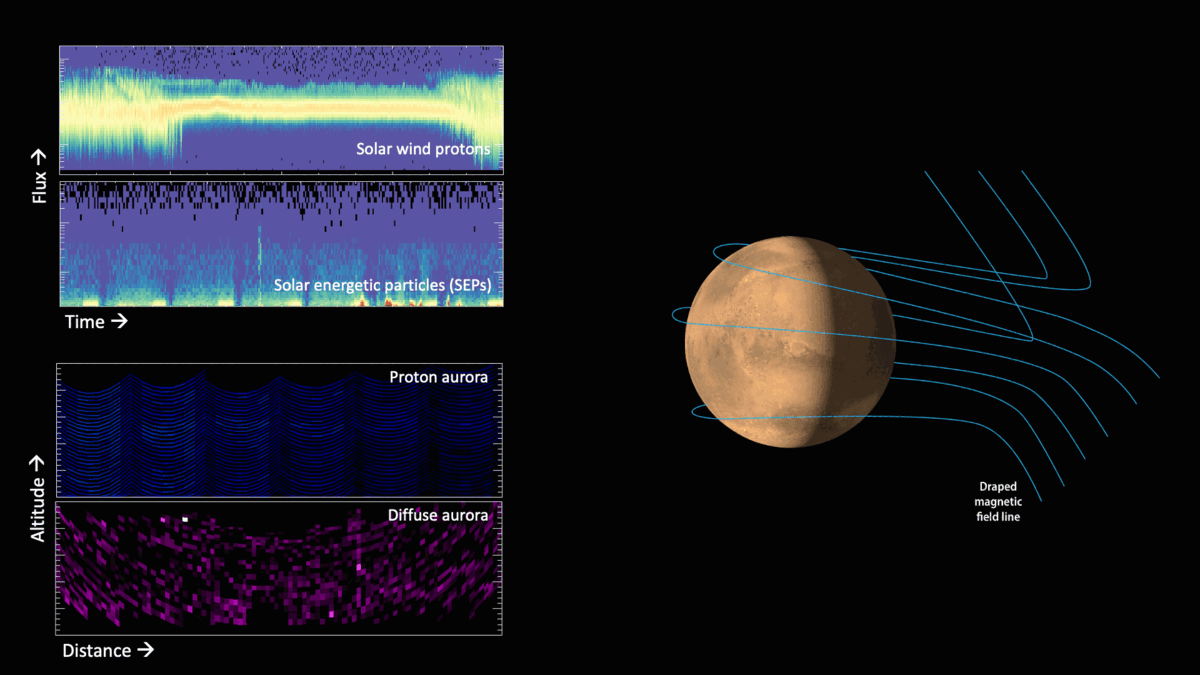Mars orbiter notches 1st sighting of simultaneous auroras with different causes
The auroras were spotted on both the day and night sides of the Red Planet.

NASA's MAVEN mission to Mars captured a rare event when it spotted two different types of aurora in the sky over the Red Planet at the same time as Mars was being buffeted by a tumultuous solar storm.
On Aug. 27, the sun erupted. A series of solar flares raced through the solar system, followed by a coronal mass ejection (CME) — an enormous cloud of plasma ripped from the solar corona by the energy of the flares. Over the course of the next few days, Earth and Mars experienced a titanic solar storm as charged particles struck them. Earth has a magnetic field that deflects these particles, but Mars does not.
MAVEN, the Mars Atmosphere and Volatile Evolution mission, which has been in orbit around the Red Planet since 2014, is designed to study Mars' upper atmosphere and how it interacts with the solar wind and solar storms. Racing ahead of the CME was a wave of solar energetic particles (SEPs), which are high-energy charged particles accelerated by solar flares and which are more energetic than typical solar wind particles; the CME eruption on Aug. 27 resulted in some of the brightest SEP events at Mars that MAVEN has seen in the eight years since it arrived.
"By utilizing space-weather models of CME propagation, we determined when the structure would arrive and impact Mars," Christina Lee, MAVEN mission scientist at the University of California, Berkeley, said in a statement. "This allowed the MAVEN team to anticipate some exciting disturbances in Mars' atmosphere from the impacts of the interplanetary CME and the associated SEPs."
Related: NASA's Mars MAVEN spacecraft spent 3 months on the brink of disaster
In particular, these disturbances resulted in two types of ultraviolet auroras, marking the first time that MAVEN has seen both types glowing concurrently. Bringing a whole arsenal of instruments to bear, MAVEN was able to monitor these auroras as they shimmered over the planet's red sands.
The first type of aurora was a proton aurora seen on Mars' dayside, triggered in part by Mars nearing the end of its dust storm season. Dust storms can inject a lot of energy into Mars' atmosphere, heating it up and allowing water molecules to reach higher into the sky. At higher altitudes, solar ultraviolet light can break the molecules into their constituent atomic nuclei, including hydrogen nuclei, which are just protons.
Get the Space.com Newsletter
Breaking space news, the latest updates on rocket launches, skywatching events and more!
When regular charged particles of the solar wind strike these atmospheric protons, they produce an ultraviolet glow over the planet's dayside, known as a proton aurora. Recently, the United Arab Emirates' Hope Mars mission has discovered that these proton auroras appear patchy, highlighting areas that receive more bombardment by the solar wind.

Meanwhile, the SEPs brought to Mars by the solar storm were able to ride magnetic field lines in the solar wind all the way to Mars. The Red Planet impinges on this magnetic field, which wraps around Mars. Consequently, the SEPs followed the field lines of the solar wind's magnetic field to the nightside of the planet. Here, they penetrated deep into Mars' atmosphere and collided with atmospheric molecules to produce a second auroral phenomenon, the diffuse aurora.
The combination meant that MAVEN was observing auroras on both the day- and nightside of Mars at the same time.
As the sun's cycle of activity continues toward its maximum sometime around 2024 or 2025, scientists expect to see more of these events at Mars as more and increasingly powerful solar flares and CMEs erupt on the sun.
"I was so surprised to see proton aurora at the same time as diffuse aurora, because it had never happened before," Sumedha Gupta, a postdoc with the IUVS team at the University of Colorado, Boulder, said in the statement. "They're both increasing with solar activity, so we hope it keeps happening!"
Follow Keith Cooper on Twitter @21stCenturySETI. Follow us on Twitter @Spacedotcom and on Facebook.
Join our Space Forums to keep talking space on the latest missions, night sky and more! And if you have a news tip, correction or comment, let us know at: community@space.com.

Keith Cooper is a freelance science journalist and editor in the United Kingdom, and has a degree in physics and astrophysics from the University of Manchester. He's the author of "The Contact Paradox: Challenging Our Assumptions in the Search for Extraterrestrial Intelligence" (Bloomsbury Sigma, 2020) and has written articles on astronomy, space, physics and astrobiology for a multitude of magazines and websites.









